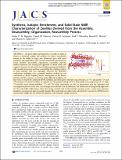Files in this item
Synthesis, isotopic enrichment and solid-state NMR characterization of zeolites derived from the assembly, disassembly, organisation, reassembly process
Item metadata
| dc.contributor.author | Bignami, Giulia P. M. | |
| dc.contributor.author | Dawson, Daniel M. | |
| dc.contributor.author | Seymour, Valerie R. | |
| dc.contributor.author | Wheatley, Paul S. | |
| dc.contributor.author | Morris, Russell E. | |
| dc.contributor.author | Ashbrook, Sharon E. | |
| dc.date.accessioned | 2017-04-24T14:30:13Z | |
| dc.date.available | 2017-04-24T14:30:13Z | |
| dc.date.issued | 2017-04-12 | |
| dc.identifier | 249464908 | |
| dc.identifier | 2b565993-1679-4a7c-bcb8-75aad9bced02 | |
| dc.identifier | 85018252853 | |
| dc.identifier | 000399353800029 | |
| dc.identifier.citation | Bignami , G P M , Dawson , D M , Seymour , V R , Wheatley , P S , Morris , R E & Ashbrook , S E 2017 , ' Synthesis, isotopic enrichment and solid-state NMR characterization of zeolites derived from the assembly, disassembly, organisation, reassembly process ' , Journal of the American Chemical Society , vol. 139 , no. 14 , pp. 5140-5148 . https://doi.org/10.1021/jacs.7b00386 | en |
| dc.identifier.issn | 0002-7863 | |
| dc.identifier.other | ORCID: /0000-0002-4538-6782/work/56638907 | |
| dc.identifier.other | ORCID: /0000-0002-8110-4535/work/34029106 | |
| dc.identifier.other | ORCID: /0000-0001-7809-0315/work/61622068 | |
| dc.identifier.uri | https://hdl.handle.net/10023/10649 | |
| dc.description | We would like to thank the ERC (EU FP7 Consolidator Grant 614290 “EXONMR”), the Leverhulme Trust (IN-2012-094), and EPSRC (EP/K025112/1, EP/L014475/1, and EP/M506631/1 (for GPMB)). S.E.A. would like to thank the Royal Society and the Wolfson Foundation for a merit award. The research data (and/or materials) supporting this publication can be accessed at DOI: 10.17630/d66d1146-5892-4f14-8e41-dfc075a8cd91. | en |
| dc.description.abstract | The great utility and importance of zeolites in fields as diverse as industrial catalysis and medicine has driven considerable interest in the ability to target new framework types with novel properties and applications. The recently introduced and unconventional assembly, disassembly, organization, reassembly (ADOR) method represents one exciting new approach to obtain solids with targeted structures by selectively disassembling preprepared hydrolytically unstable frameworks and then reassembling the resulting products to form materials with new topologies. However, the hydrolytic mechanisms underlying such a powerful synthetic method are not understood in detail, requiring further investigation of the kinetic behavior and the outcome of reactions under differing conditions. In this work, we report the optimized ADOR synthesis, and subsequent solid-state characterization, of 17O- and doubly 17O- and 29Si-enriched UTL-derived zeolites, by synthesis of 29Si-enriched starting Ge-UTL frameworks and incorporation of 17O from 17O-enriched water during hydrolysis. 17O and 29Si NMR experiments are able to demonstrate that the hydrolysis and rearrangement process occurs over a much longer time scale than seen by diffraction. The observation of unexpectedly high levels of 17O in the bulk zeolitic layers, rather than being confined only to the interlayer spacing, reveals a much more extensive hydrolytic rearrangement than previously thought. This work sheds new light on the role played by water in the ADOR process and provides insight into the detailed mechanism of the structural changes involved. | |
| dc.format.extent | 9 | |
| dc.format.extent | 3539877 | |
| dc.language.iso | eng | |
| dc.relation.ispartof | Journal of the American Chemical Society | en |
| dc.subject | QD Chemistry | en |
| dc.subject | DAS | en |
| dc.subject | BDC | en |
| dc.subject | R2C | en |
| dc.subject.lcc | QD | en |
| dc.title | Synthesis, isotopic enrichment and solid-state NMR characterization of zeolites derived from the assembly, disassembly, organisation, reassembly process | en |
| dc.type | Journal article | en |
| dc.contributor.sponsor | EPSRC | en |
| dc.contributor.sponsor | European Research Council | en |
| dc.contributor.sponsor | The Leverhulme Trust | en |
| dc.contributor.sponsor | EPSRC | en |
| dc.contributor.sponsor | EPSRC | en |
| dc.contributor.sponsor | The Royal Society | en |
| dc.contributor.institution | University of St Andrews. School of Chemistry | en |
| dc.contributor.institution | University of St Andrews. EaSTCHEM | en |
| dc.contributor.institution | University of St Andrews. Centre of Magnetic Resonance | en |
| dc.identifier.doi | https://doi.org/10.1021/jacs.7b00386 | |
| dc.description.status | Peer reviewed | en |
| dc.identifier.grantnumber | EP/F018096/1 | en |
| dc.identifier.grantnumber | 614290 - EXONMR | en |
| dc.identifier.grantnumber | IN-2012-094 | en |
| dc.identifier.grantnumber | EP/K025112/1 | en |
| dc.identifier.grantnumber | EP/L014475/1 | en |
| dc.identifier.grantnumber | WM150021 | en |
This item appears in the following Collection(s)
Items in the St Andrews Research Repository are protected by copyright, with all rights reserved, unless otherwise indicated.

